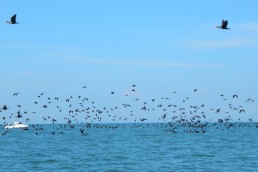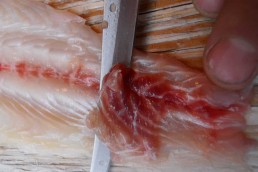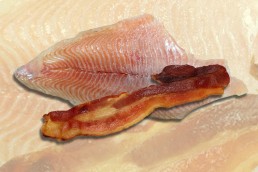Cormorants Spared this Spring from Ohio Culls
SHARE THIS POST
In 1992, bird lovers rejoiced the return of the double-crested cormorant when its first nest in Ohio in 100 years was documented on West Sister Island. Since then, their overwhelming population explosion into the tens of thousands in Lake Erie and elsewhere has been cursed by fishermen and bird watchers alike.
Due to concerns of these commercial fishermen, southern catfish farmers, government hatchery staff, avian biologists and others, there was an Eastern Recreational Fishing Depredation Order permit granted by the U.S. Fish and Wildlife Service. Working with the U.S. Department of Agriculture’s Animal Plant and Health Inspection Service’s (APHIS) Animal Control Unit and staff from the Ottawa National Wildlife Refuge, the Ohio Division of Wildlife (DOW) used the permit to reduce cormorant numbers on West Sister and Green islands in Lake Erie and also Turning Point Island in Sandusky Bay.
But don’t jump to the conclusion that the biologists want to protect Lake Erie’s fish from these voracious predators, even though each one consumes an average of 1.8 pounds of fish each per day. In Ohio’s case, they used the culls to protect the understory vegetation and young trees from the cormorant’s droppings, which were burning the foliage with the higher acidic pH levels, but also to reduce competition with other more rare bird species. For culling, the birds are shot prior to their nesting season with noise-suppressed air rifles and .22-caliber rifles.
On West Sister Island, notable populations of greater egrets, great blue herons, black-crowned night herons, cattle egrets and snowy egrets, count on intact trees in various stages of growth for their specific nesting habitat preferences. To help these important rookeries, 1,413 cormorants had to be killed there last year. On Green Island, 822 cormorants were shot last year after hundreds of birds had visibly defoliated the mature hackberry and other trees. The DOW had hoped to prevent the species from establishing a nesting colony there, but they were able to reduce the number of nesting pairs. On Turning Point Island, where 3,352 cormorants were killed last year, the culls were designed to reduce competition with state-endangered common terns, birds that nest in only a few locations in Ohio.
Last year, a group called Public Employees for Environmental Responsibility filed a lawsuit challenging how the U. S. Fish and Wildlife Service (USFWS) addressed the Environmental Review section when they approved cormorant depredation permit renewals without considering non-lethal alternatives such as egg oiling, replacement and harassment. They also pointed out that nobody was documenting the effect of the culls on fish populations to see if it was meeting the expectations of the permit.
The judge ruled that the USFWS must follow National Environmental Policy Act (NEPA) requirements and perform an environmental review before any permit would be honored, renewed or issued. Due to other obligations, APHIS did not begin the lengthy process required to obtain one for 2017.
As a result, Ohio will not be allowed to conduct cormorant culls this spring, according to Laura Kearns, a wildlife biologist stationed at the ODNR, and DOW’s Olentangy Research Station in Delaware.
Kearns is hopeful that the permit will be issued in time to resume the culls in 2018, citing Ohio’s unique motivation to prevent detrimental effects to island vegetation and not just to protect fish from overconsumption.
She says that the DOW also practices due diligence by notifying affected parties prior to the culls, performing good science including monitoring the impacts of the cull, following the rules of the permit, staying within their prescribed quotas and filing reports in a timely manner.
In the absence of the annual culls, she says that the biologists will still document the cormorant populations at the locations of concern.
Are you enjoying this post?
You can be among the first to get the latest info on where to go, what to use and how to use it!
In other areas, a total of 89 cormorants were also culled last year on Safety Island in Grand Lake St. Marys to protect the vegetation from guano burn out so that the tree roots would hold the island’s soil together to prevent erosion.
At the nearby St. Marys State Fish Hatchery, Superintendent Morton Pugh says that more than 100 cormorants at a time have often arrived on their ponds in recent years, intent to prey on their fish. He fears overall losses of 20 to 40 percent this season without being able use the depredation permit. He added that this hatchery is important for some statewide stocking efforts and officials say chasing them only herds them to the other end of the pond or to another one.
Some of the fingerling channel catfish from St. Marys goes to Hebron State Fish Hatchery to grow for another year before stocking them. Losses to the blue catfish, which were difficult to obtain and expensive to feed, would be devastating. St. Mary’s also raises all of the fathead minnows used to feed fingerling muskies at the Kinkaid and London hatcheries and their broodstock of yellow perch produced the record numbers used for statewide inland stocking efforts last year.
Rich Carter, executive administrator of Fish Management adds, “Our St. Marys Hatchery staff will have to spend significant effort during periods of increased cormorant activity in an attempt to minimize our losses and force birds to roost and feed elsewhere since they can’t be culled. Hatchery staff will employ known harassment methods and will seek novel ways to keep flights of cormorants moving along and not setting up feeding patterns on our hatchery fish and ponds.”
The Black Swamp Bird Observatory, a leading conservation group headquartered at Magee Marsh, supports the culls as a necessary action for the preservation of even more rare bird species and to maintain balance of the entire ecosystem.
Kimberly Kaufman, the executive director for the group, called the recent cormorant population explosion “especially devastating” to local herons and egrets based upon more than 25 years of research at West Sister Island.
Lake Erie fishermen may notice additional birds flying around this summer, but hopefully the population boost does not result in too much damage to the islands or to the fish. Studies in eastern Lake Ontario and New York’s Lake Oneida concluded that they have negatively impacted yellow perch and walleye numbers.
Carter noted that previous cormorant diet studies in Erie have shown them to favor feeding on soft-rayed fish species. He doesn’t expect to see any fish level population impacts on Lake Erie this year, but concedes saying that there is always the chance that very localized fish populations could be impacted around the islands that would have had culling.
“We would be concerned if our inability to cull extended beyond this year.”
MWO
SHARE THIS POST
Did you enjoy this post?
You can be among the first to get the latest info on where to go, what to use and how to use it!
John Hageman
John Hageman was manager of Stone Laboratory, Ohio Sea Grant's Biology Station at Put-in-Bay, for 25 years and formerly a licensed Lake Erie ice-fishing guide. He is active with the Outdoor Writers of Ohio and several sportsmen's conservation organizations. He may be contacted at hageman.2@osu.edu.



